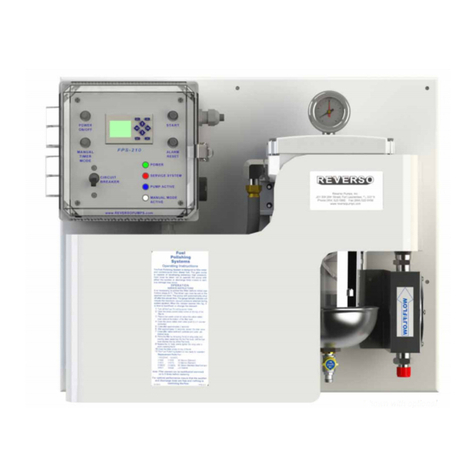
3
Description
System Description
Reverso Automatic Fuel Polishing (AFP) System is
designed for middle distillate fuels with ash points
of 100°F and above. This includes #1,2 and 3 diesel
fuel, home heating oil and bio-diesel up to B20, with no
modications required. The AFP single-tank system is
designed specically to maintain diesel fuel quality in
storage tanks and standby generator sub-base tanks.
This is accomplished by rst removing all free water
and particulate to 30 micron in the primary fuel water
separator by Separ Filter, and further reducing particulate
to as low as 2 micron through a secondary lter. This
system is constructed with a 7-day programmable digital
timer, with alarms for high vacuum and high water in the
primary lter, and high pressure in the secondary lter. A
drip pan high level oat alarm is also included. Enclosure
is NEMA 3 rated for outdoor installations.
Control
The AFP system operates at 120 volt 60Hz. This system
is equipped with an IDEC PLC control for unattended
operation and is UL508 listed. All system controls are
housed in a NEMA 4 water-tight control box.
Digital control with 7 day programming provides exibility
in scheduling polishing operations. User can create a
weekly schedule to automaticallly run the system.
The following monitoring systems are provided:
Primary lter high vacuum
Primary lter high water
Secondary lter high pressure
Drip tray high level
When equipped with an enclosure option, an electrical
junction box is located on the exterior and houses the
emergency stop button.
Primary Filtration
The Reverso AFP-600 is designed around the Separ
Filter brand of diesel fuel water separators. This lter
has been specically designed to utilize hydrodynamic
principles to remove free water and particulate from the
ow of the fuel. By changing the direction of ow and
the velocity of the fuel multiple times, and imparting
centrifugal force, the heavier particulate and free water
drop from suspension and fall to the bottom of the bowl.
As these natural laws are put into effect on the fuel, it
passes through 5 stages within the Separ Filter housing.
For this reason, approximately 70+% of the contaminants
are removed from the fuel prior to passing through
the nal stage lter element, bringing the particulate
removal efciency to 100% for particulate larger than the
element rating (30 micron standard) and a high level
of separation for smaller particulate in test uid using
standard test methods. At the rated ow of 10 gallons
per minute, the lter is 100% efcient at removing
free water as certied by the RWTUV testing facility in
Germany (copy available upon request).
The 5 stages of separation and ltration are:
Refer to Diag. 1
1. After entering the inlet(s), the 1st vane system
spins the diesel fuel in a circular motion,
generating centrifugal force.
2. In the bowl, fuel continues to spin – separating
water and heavier particulates, through centrifugal
force.
3. A 2nd vane system then forces the fuel ti spin in
a different direction – separating smaller water
droplets and ner particulates.
4. A wider passage, just below the element, slows
down fuel to allow more contaminants to settle into
the bowl.
5. Finally, the element lters ner particulates out of
the fuel before exiting through the outlet(s).
Secondary Filtration
Once fuel has been ltered, it passes through the
pump and nally to a 2 micron lter. It removes
particulate contaminant such as dirt, dust and rust. The
cellulose/microglass media offers higher efciencies
and longer lter life. Gaskets are pre-lubed. It is
recognized by the Underwriters Laboratory (UL®) for
use with service station pumps and dispensers.
Optional Features
Certain applications can benet from optional features,
which are additional to the standard AFP System.
Contact your representative for details and pricing.
• Enclosure
• Enclosure for cold climate
• Stand for enclosure
• Magnetic fuel conditioner
• Flow meter
• Automatic Water Drain System for primary lter
• Basic touchscreen control panel
• Advanced touchscreen control: Includes
integration with Building Management Systems
(BMS)




























